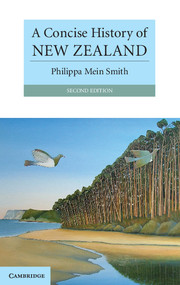Book contents
- Frontmatter
- Contents
- Illustrations
- Acknowledgements
- Preface
- 1 Waka across a watery world
- 2 Beachcrossers 1769–1839
- 3 Claiming the land 1840–1860
- 4 Remoter Australasia 1861–1890
- 5 Managing globalisation 1891–1913
- 6 ‘All flesh is as grass’ 1914–1929
- 7 Making New Zealand 1930–1949
- 8 Golden weather 1950–1972
- 9 Latest experiments 1973–1996
- 10 Treaty revival 1973–1999
- 11 Shaky ground
- Glossary Of maori words
- Timeline
- Sources of Quotations
- Guide to Further Reading
- Index
5 - Managing globalisation 1891–1913
Published online by Cambridge University Press: 05 October 2013
- Frontmatter
- Contents
- Illustrations
- Acknowledgements
- Preface
- 1 Waka across a watery world
- 2 Beachcrossers 1769–1839
- 3 Claiming the land 1840–1860
- 4 Remoter Australasia 1861–1890
- 5 Managing globalisation 1891–1913
- 6 ‘All flesh is as grass’ 1914–1929
- 7 Making New Zealand 1930–1949
- 8 Golden weather 1950–1972
- 9 Latest experiments 1973–1996
- 10 Treaty revival 1973–1999
- 11 Shaky ground
- Glossary Of maori words
- Timeline
- Sources of Quotations
- Guide to Further Reading
- Index
Summary
A changed attitude to globalisation emerged out of the aura of crisis: now there was a growing trend to manage it. The Australasian colonies resolved to seize opportunities to develop new commodities for export, yet manage the social outcomes by building an edifice of progressive liberal ‘state experiments’. Led by Premiers John Ballance until 1893, Richard Seddon until 1906, and Sir Joseph Ward – all of whom were immigrants – a series of Liberal governments from 1891 to 1912 set out to create New Zealand as a democratic social laboratory. In doing so, they enacted an Australasian model of state development.
Political scientists have shown how Australian institutions have mediated globalisation through a colonial, democratic citizenship. The ‘Australian Settlement’, supposedly established at federation, had as its five planks a white Australia, and associated restricted immigration; arbitration; protection; ‘state paternalism’; and ‘imperial benevolence’. In reality it was Australasian: a distinctive Australian and New Zealand settler colonial response to guarantee ‘domestic defence’ against a range of shared perceived and actual external threats.
- Type
- Chapter
- Information
- A Concise History of New Zealand , pp. 100 - 127Publisher: Cambridge University PressPrint publication year: 2011



